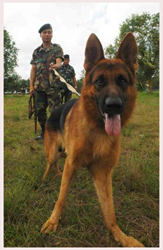Four-legged bomb detector more effective than GT200?
 By Sumeth Parnpetch
By Sumeth Parnpetch
Ever since the introduction of GT200 bomb detector to the deep South a few years ago, it appears that the four-legged bomb sniffers which haves had an impressive working record have taken a back seat to the extent that this so-called “man’s best friend” has been virtually forgotten.
In wake of the controversy over the effectiveness of the British-made GT200 bomb detector, the Isra news team recently revisited the Anothai military dog platoon or the Yalae Unit at the Ingkayuth barrack in Nong Chik district of Pattani and talked to the dog handlers.
Captain Pattanasak Prasomsri, commander of the Anothai military dog platoon, disclosed that bomb sniffing dogs had been employed in service in the restive far South at the 43rd Task Force Command more than a decade ago. It was only after the armoury robbery on January 4, 2004, in Jo Airong district of Narathiwat that the service was officially recongnised and a military dog unit was set up. At the beginning, the unit comprised eight dogs and 12 men. But the strength was boosted to 12 dogs and 22 men a year later; to 18 dogs and 30 men in 2008 and finally to 34 dogs and 54 men this fiscal year.
Captain Pattanasak said that the increase of the number of dogs and men was intended to support field troops in the three southernmost provinces with Yala and Pattani each getting one team of military dogs which comprises four dogs and six men whereas Narathiwat gets two teams.
The four dogs in each team were separately trained on four different missions: bomb detection, patrolling, tracking and parcel bomb sniffing. Each dog is handled by an officer.
According to the Captain Pattanasak, the dogs which are selected for training are either German Shepherd or Labrador aged 10-12 months. The basic training lasts four months after which they will be sent to perform their designated missions. Each team averages 100 missions within a month.
“It has been proven, time and again, that the dogs have never failed in their missions. They have often sniffed out hidden bombs after which bomb disposal units were called in to defuse the bombs,” said the captain, adding that one of the dogs has tracked down a suspected militant after he shot a teacher in Kok Po district of Pattani in 2009 and left behind a sandal at the scene of the shooting.
Despite the introduction of GT200 bomb detector which has been widely used in the restive region, the use of sniffer dogs is continuing but its role appears to have been overshadowed by the device.
But inspite of their reliability and effectiveness, sniffer dogs are not always welcome in Muslim communities due to religious reason. “I used to raise the problem with some religious experts and were told that Muslim people can touch dogs if they are not wet. But however in actual practice, the dogs are not welcome whether they are dry or wet,”said the army captain.
The cost of the training of each sniffer dog is about 100,000, including the cost of the canine itself which averages 30,000 baht. But considering the cost of dog food, about 182 kilogrammes per year plus medical cost of about 1,800 baht annually and the years in service for each dog which averages ten years, then it is more economical besides more effective to use sniffer dogs in bomb and drugs detection than GT200 which costs between 900,000-1.2 million baht apiece depending on the number of sensor cards to be inserted into the device.
Captain Pattanasak further said that not a single sniffer dog was killed or injured in bomb explosion during their many years in service in the field.
Pvt Praphan Chomkokkuad, a dog handler, told Isra news team, of Senol, a female Germ Shepherd trained in surveillance. Senol was one-year old when it was recruited for training in patrolling has been in the service for four years.
“Senol is very smart and has never failed once in her missions. Her nose is very sensitive and she will immediately sense explosives from a distance,” he said. However, he admitted that handling the dog is not easy; as it needs high degree of patience and tolerance.
“The most important thing is to get the dog familiar with you, listen to you and understand your orders. Even though I am able to control or order my dog, there is one thing that I cannot ignore that is to always keep the dog reminded or the various orders. Like human beings, the dogs can forget.”
Like buddy-buddy, Praphan said that the dog handler has to be with his dog not just during the mission but almost all the time.
“I and Senol are like father and daughter. Dogs are very close to humans and they need love and care from their owners. Our close contact and interaction with them will help improve our relationship and will result to their improved effectiveness,” said Praphan.
Another dog handler, Pvt Samart Kaisongkhram, said that female dogs were more cautious and reliable and, therefore, used in bomb detection.
With about 30 years experience in handling dogs, Samart admitted that there are no devices which are as effective and reliable than trained dogs in tracking criminal suspects.
